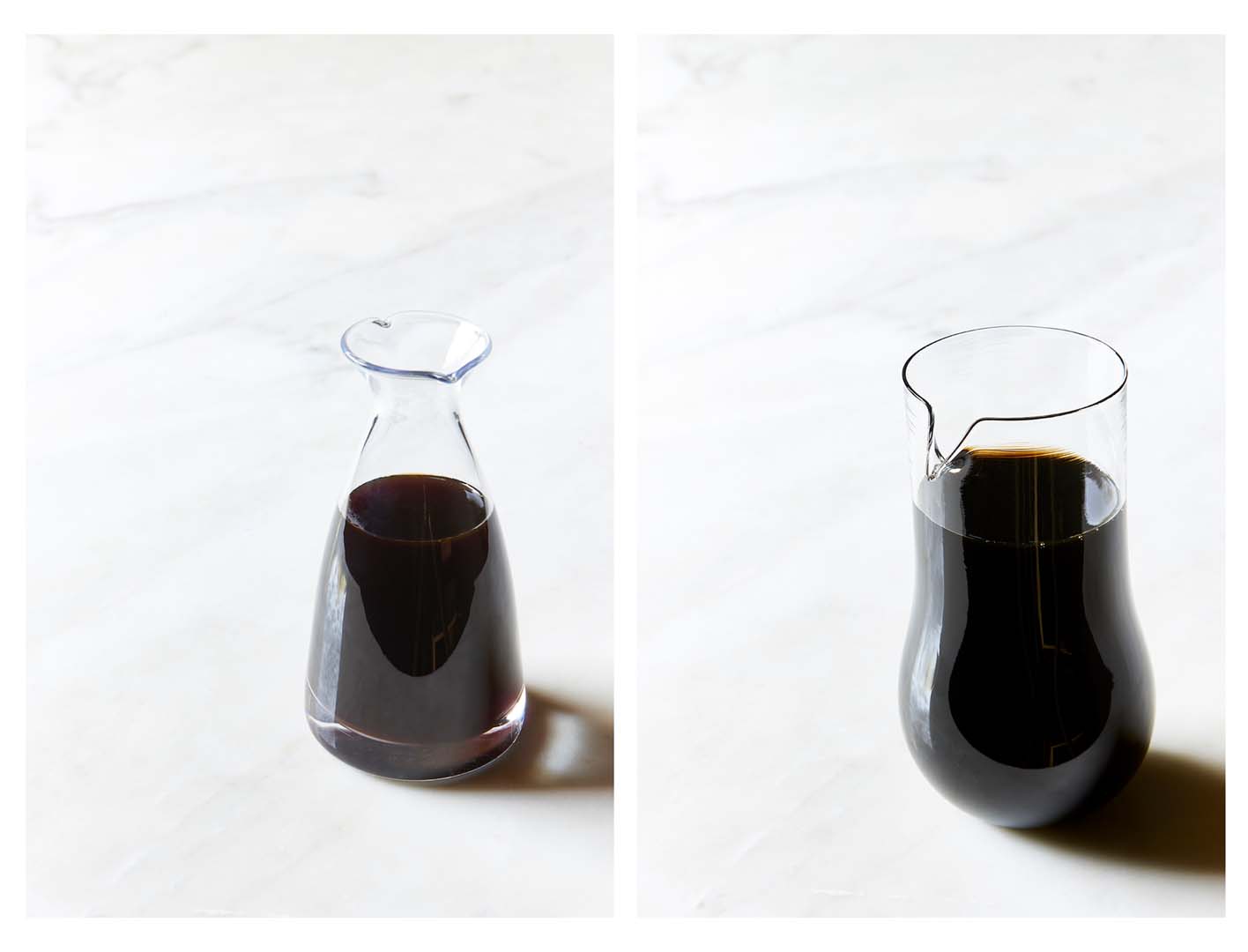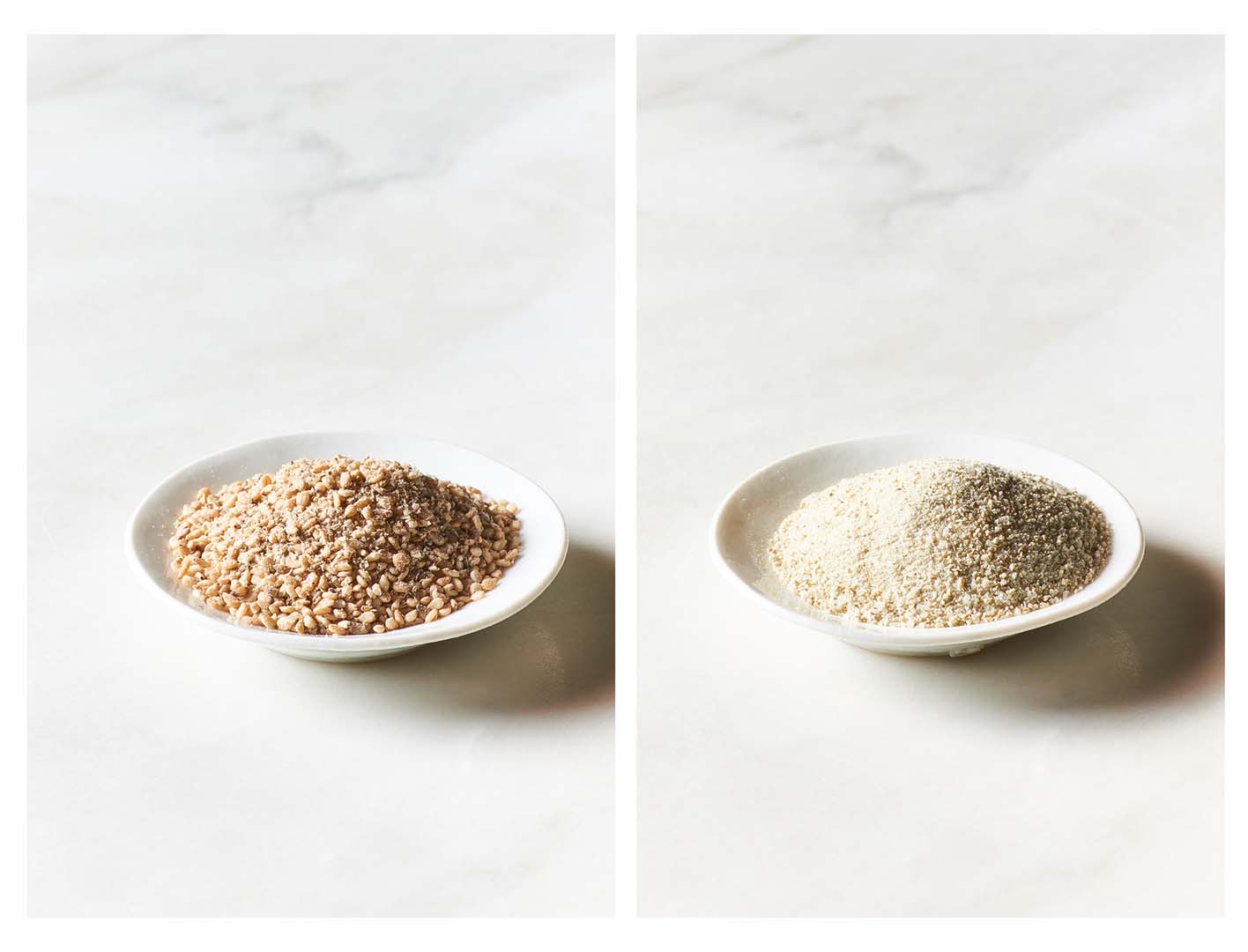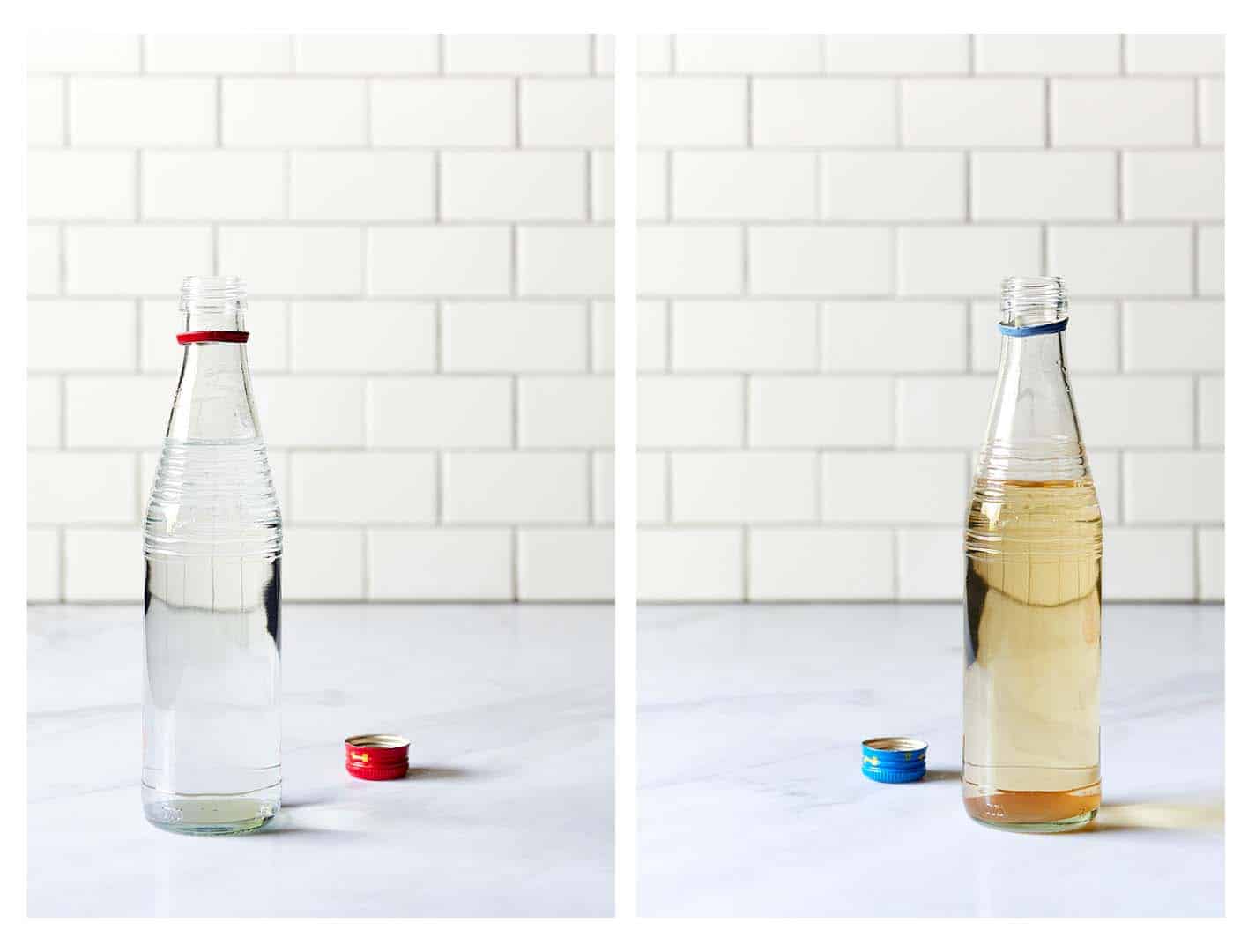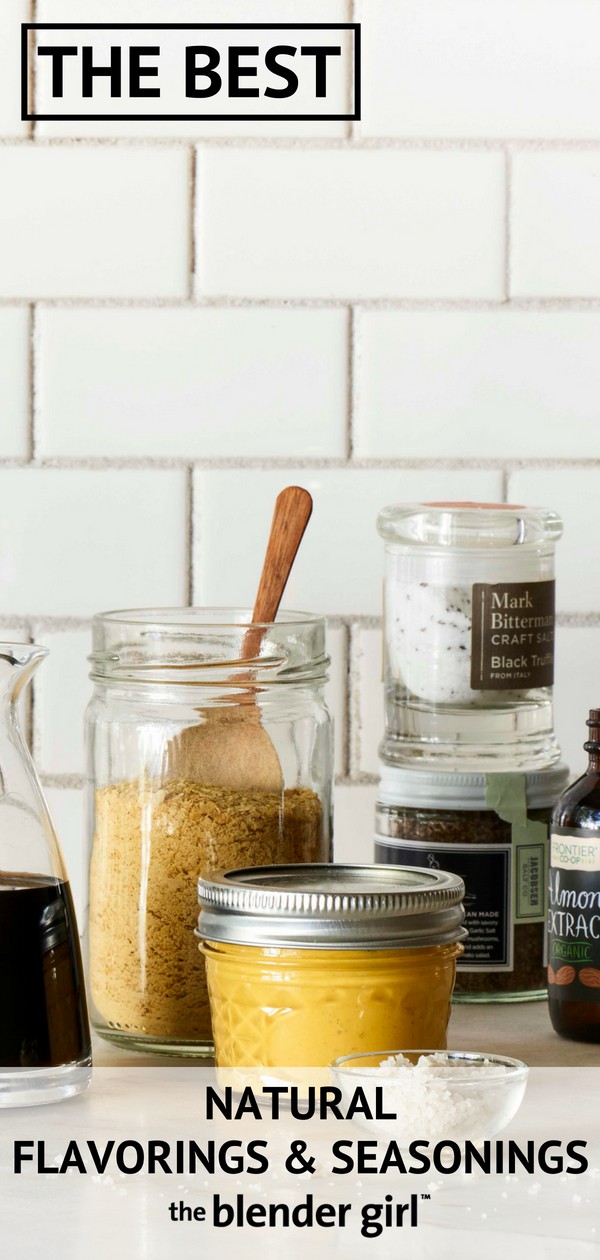Natural Flavorings and Seasonings
Tips for selecting, storing, cooking, and serving sea vegetables to create delicious healthy recipes.
Flavorings and Seasonings
There are a variety of go-to ingredients that I use repeatedly in the recipes on this site and in my cookbooks and app to create fantastic flavors in healthy recipes.
Here is the lowdown on how to select, store, and use them to create your own dishes.

Vanilla
I use vanilla beans and vanilla extract in a lot of recipes to add flavor.
For a strong vanilla profile, a generous amount of vanilla is good. For a nice rounded accent, start with 1 teaspoon, and add to taste.
Vanilla enhances the flavor of chocolate, coffee, nuts and fruit in raw and cooked dishes.
Break open a vanilla bean and scrape out the beans and pulp, use prepared vanilla paste, or use vanilla extract, which is the easiest, most accessible, and affordable form of vanilla.
Vanilla extract is made by squeezing the essential oils from the vanilla bean and mixing it with a vegetable oil (usually soybean oil) or glycerin base. I purchase vanilla extract with a glycerin base.
I use high-quality natural vanilla extract in the recipes. You can find this good vanilla extract at health food stores and some grocers. Frontier Co-op or Nielsen-Massey both have great vanilla products.
The “imitation vanilla” extract or "vanilla flavored" extract is full of sugar, treated with chemicals by soaking alcohol in wood that contains vanillin as it has a chemical-like flavor. Natural vanilla extract has a superior flavor.
However, I understand imitation vanilla is much more affordable. If you're using vanilla-flavored extract in the recipes on this site or in my cookbooks halve the quantity called for, and add to taste.
Liquid Extracts
Natural, alcohol-free liquid extracts in flavors such as almond, lemon, peppermint and coconut can be really useful to boost the flavors of smoothies, desserts, and baked goods.
These natural extracts are made by squeezing the essential oils from the respective food and mixing it with a vegetable oil base (usually soy) or glycerin base with water.
I choose the glycerine-based liquid extracts from Frontier Co-op. These flavorings don’t contain sugar and so don’t feed yeast. So, these liquid flavorings are suitable for diabetics or those following an anti-candida diet such as The Body Ecology Diet.
These liquid flavorings are usually quite potent, so a little goes a long way. This is particularly true of almond and peppermint flavors. Start with 1/8 teaspoon, and add more to taste.
Store these liquid extracts in a cool dark pantry.
Nutritional Yeast
Nutritional yeast or “savory yeast flakes” (as it is called in Australia and New Zealand) is a deactivated yeast that is made by culturing yeast with beet molasses and sugarcane and drying it. It is widely available from health food stores as yellow flakes or ground powder.
Nutritional yeast has a strong nutty cheesy flavor that is good for making vegan cheese, sauces, dips, and other savory dishes.
It is also fantastic sprinkled on popcorn.
Don’t confuse nutritional yeast with brewer’s yeast. They are not the same, and behave differently in recipes.
Nutritional yeast is a good source of protein with a complete amino acid profile. It also contains vitamins and is typically fortified with vitamin B12.
Store nutritional yeast a sealed container in the pantry.

Miso Paste
This probiotic-rich paste is traditionally made by fermenting soybeans with barley or rice, but is now available in soy-free and gluten-free varieties using other grains and chickpeas.
Color and flavor vary with base ingredient and fermentation time.
Miso pastes contain antioxidants, vitamins, minerals, protein, enzymes, and inflammatory agents that support intestinal microflora and digestion, boost immunity, and aid circulation.
To preserve the probiotic potential of miso paste use it raw or slightly warmed. Never bring it to a boil.
My favorite types of miso are Genmai (brown rice) miso, sweet white (white rice) miso, yellow (white rice) miso, and chickpea miso.
- Red or white miso adds a rich flavor to soups and stews.
- Red miso paste is used to glaze vegetables and make robust earthy sauces such as miso-glazed eggplant.
- Sweet white , yellow, or chickpea miso adds a cheesy quality to pesto, sauces, dressings, and marinades.
Try making a coconut miso soup with creamed coconut and miso paste with some chopped vegetables and seaweed. It makes a scrumptious strengthening breakfast with a scoop of grain in the winter.

Cacao Powder
The most nutrient-dense form of chocolate, raw cacao beans are the seeds of the fruit the cacao tree native to South America the West Indies.
Raw cacao powder makes a fantastic drink substitute for coffee and tea and is one of the best known food sources of magnesium which aids the absorption of calcium and supports healthy heart and muscle function. Raw cacao also contains other essential minerals such as calcium, iron, zinc, potassium and sulphur.
But best of all, raw cacao keeps us happy! Not only does it taste absolutely phenomenal, it contains Phenythylamine (PEA) which helps to increase mental focus and alertness. It also contains inhibitors that allow more seratonin to circulate in the brain; and contains neurotransmitters such as dopamine and anandamine.
Raw cacao beans have an impressive anti-oxidant profile that contains fourteen times more antioxidant flavonoids than red wine, twenty-one times more than green tea, and seven times more than dark chocolate. Pure raw cacao beans, nibs and powder contain no sugar and a lower fat content than most other nuts; and are a much healthier alternative to conventional chocolate which contains milk solids and sugar.
Cacao is still a stimulant, can strain on the adrenal system. It should be consumed in moderation.
I like to eat handfuls of raw cacao nibs as a snack when I am traveling with Goji berries or fruit. I also throw them into smoothies and shakes for a chocolate hit. They are wonderful blended into raw ice creams, puddings, and cookies or used as a topping for cereals and fruit. Try making oatmeal with coconut milk and topping with raw cacao nibs and maple syrup for a blissful comforting treat in the Winter.
Cocoa Powder
This powder is made by grinding roasted cacao beans. Cacao nibs are ground into a chocolate liquor which is then pressed to separate out the cocoa butter and the cocoa solids.
Unsweetened cocoa powder is produced when these cocoa solids are pressed again to remove the majority of the cocoa butter. This substance is then dried and ground to produce a natural cocoa powder that is very strong and dark and naturally acidic.
It is this unsweetened cocoa powder that is best for gluten free baking, as natural acidity reacts well with baking powder to enable baked goods to rise.
This is especially important with gluten free flours that need all the help they can get! “Dutch” cocoa or alkalized cocoa powder is produced by adding an alkali which neutralizes the acids creating a cocoa powder with a milder flavor and lighter reddish/brown color.
This cocoa is not appropriate for baking where you want a rise. The extra alkali can cause baked goods to fall flat or rise unevenly. But it is fantastic for pastries and cookies and for puddings, pies, and smoothies as it is less acidic and more soluble.
I use organic fair trade cocoa powder when I use alkalized cocoa powder. It sets the bench mark for depth of flavor, not to mention, ethical production standards.
If I want a really intense chocolate flavor I will use dark chocolate pieces in addition to cocoa powder. But if I just want a hint of chocolate to enhance the flavor of nuts like hazelnuts, macadamias and chestnuts I will just use cocoa powder.
Carob Powder
With a caramel-like flavor carob requires very little sweetener with it, and is sensational for use in smoothies, desserts, and baked goods, and I use it for a bit of variety from raw cacao nibs when adding flavor to sweet treats.
Carob powder is ground from the seeds of long carob pods from the carob tree which is a tree related to legumes grown in the Middle East. Carob pods are between four and ten inches long, and are dark brown with a series of holes that each contain a seed like a watermelon. Each carob pod can contain up to fifteen seeds. Both the seeds and the pod are edible. It is the seeds that are ground to make carob powder.
Carob powder is very often used as a healthier substitute for cocoa. Carob is free from the caffeine and therobromine that are found in chocolate. These stimulants can cause food allergies. Carob is also naturally sweet, which means that a lot less sweetener is required in order to make goods made with carob palatable.
You can buy raw or toasted carob powder. The latter is more readily available from mainstream sources. I always purchase raw carob powder, Ask your local health food store to order in the raw variety or order it online. For raw food purists, just note that a lot of carob powder that is labeled “raw” has actually been heated to about 118 degrees. Make sure you research how your carob powder has been produced to ensure you are getting what you need.
Carob powder is rich in B Vitamins and minerals such as calcium, potassium, phosphorus and magnesium, and contains some iron and manganese, as well as a bit of protein. Carob is also loaded with pectin which makes it a fantastic colon cleansing aid!
A note for people with food allergies: A lot of baked goods and vegan bars containing carob use soy flour and soy lecithin. Those with soy allergies should be mindful of this and might want to use raw cacao nibs to flavor baked treats instead.
If you're substituting carob for cacao or cocoa powder in these recipes you'll need to reduce the sweetener.

Wheat-Free Tamari
Similar to traditional soy sauce, this popular condiment adds an umami note to stir-fries, soups, stews, and sauces. It is a fantastic way to add a saltines and boot up the flavor of vegetarian dishes, and blends so well with spices such as garlic and ginger.
Tamari is a soy sauce made by brewing and fermenting soy beans with wheat. I use wheat-free tamari to keep all of the recipes gluten-free.
It has a smooth rich complex flavor that is incredibly versatile for savory dishes. Purchase organic tamari that is natural. A lot of soy sauces sold at regular grocery stores and Asian grocers contains artificial additives and preservatives, MSG and corn syrup.
Tamari can be stored in the pantry if unopened. Once opened, store in the fridge. If you do not want to consume fermented products, use Bragg's Liquid Aminos.
Those of your with soy allergies or avoiding soy, substitute with Coconut Secret coconut aminos. It is vegan, gluten free, soy free, egg free and dairy free. It tastes like a light soy sauce.

Gomasio
A macrobiotic condiment made from roasted ground sesame seeds and sea salt is an incredible substitute for plain salt salt.
Not only does gomasio contain more nutrients and flavor, but it is a fantastic garnish when plating up dishes. It is also fantastic sprinkled on grains, stir-fries, soups, stews, steamed vegetables and salads.
Eden Organics make a fantastic prepared gomasio that is widely available. Or, make your own by toasting 1 cup of raw sesame seeds in a pan until they begin to pop and release a nutty fragrance. Allow the seeds to cool and combine them with 1 ½ tablespoons of Celtic sea salt. Grind everything together in a suribachi (Japanese mortar and pestle) until the seeds are about half crushed. Store in a sealed glass container in the pantry.
Herbamare
This is a delicious proprietary blend of organic herbs and sea salt based on the original recipe from the famous Swiss naturopath, A. Vogel.
This herb blend contains sea salt, celery leaves, leek, cress, onion, chives, parsley, lovage, garlic, basil, marjoram, rosemary, thyme and kelp. These herbs are mixed with the French sea salt and steeped for about a year. This mixture is then dehydrated creating a phenomenal blend of flavors.
I use this seasoning to add a quick burst of flavor to grains, stir-fries, soups, stews and steamed vegetables.
Trocomare, (which contains horseradish) is also wonderful.
Sea Seasonings
These sea vegetable-based condiments made by Maine Coast Sea Seasonings come in a few flavors:
- Dulse with Garlic
- Nori with Ginger
- Kelp with Cayenne
The are a fantastic way to get your daily dose of mineral-rich sea vegetables.
Sprinkle on savory dishes such as grains, pilafs, stir-fries, soups, and salads.

Rose Water
The liquid that is left when roses and water are distilled to make rose oil is an incredible flavoring for sweet dishes.
Most of us are familiar with rose oil as a welcome ingredient in fragrances, bath, and skin care products. Try using rose water mixed with filtered water for a fantastic natural toner. It is amazing!
For culinary purposes, rose water has been used in Middle Eastern and Asian cuisines with spectacular results for many years. Rose water can be found at health food stores, Middle Eastern grocers, and exotic foods shops.
Try to find 100% pure rose water. Some are blends of 80% rose water, 20% water and natural flavoring. Do not buy rose syrup, which is loaded with refined sugar, citric acid, coloring and flavoring.
Rose water is wonderfully fragrant, and a nip in dishes can bring a decadent flavor that can help to reduce the amount of sweetener required.







